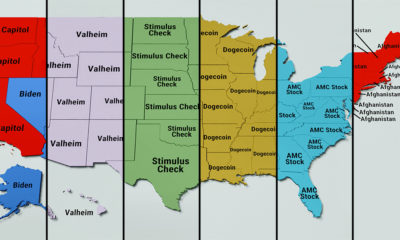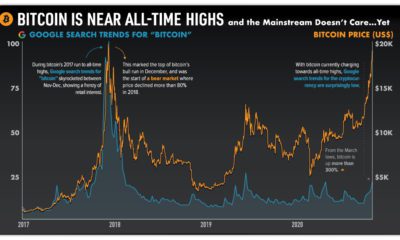Thankfully, Google search volume provides an easy avenue for measuring large-scale cultural trends. And because Google makes up more than 90% of all internet searches in the U.S., looking at what’s trending on Google is a great way to understand the shifting questions and interests that are captivating society at any given time. This animated map by V1 Analytics provides an overview of the top trending Google searches in every state over the last decade. It sheds light on what types of new information, events, and stories received the most attention in the last ten years—and more generally, it shows us what the U.S. population has been thinking about.
Trending Searches versus Top Searches
Before diving into the top trends of the decade, it’s worth taking a moment to distinguish between “trending searches” and “top searches”:
Trending Searches: Keywords that had the largest increase in traffic, in a specific period of time Top Searches: The most searched keywords in a given time frame
This video would look a lot different, and a lot less interesting, if it showed Google’s top searches. To give some perspective, here are the Top 10 Searches in the U.S. (as of 2020): Understanding the difference between trending searches and top searches is important because it gives us insight into why certain keywords trend in some places, but not others. For instance, in March 2020, the word “coronavirus” was trending throughout a majority of the U.S., with a few exceptions—it wasn’t trending in Massachusetts, California, Texas, Nevada, or Arizona. It’s easy to make the assumption that people in these states were not concerned about COVID-19—however, that’s not necessarily the case. It’s important to remember that trending searches are measured by the increase of traffic, not just the overall amount of searches. Therefore, in states where it wasn’t trending, the word “coronavirus” may have already been a popular search term for a while, so the keyword didn’t see a sudden spike in interest like it did in other places.
Undivided Attention
In the last decade, there were moments when the entire country was googling the same thing. Some keyword trends lasted a day, while others lasted over a week.
Here’s a look at keywords that took over the whole U.S, and when they were trending unanimously:
It’s interesting to look at the variety of topics that dominate the population’s collective thoughts. There’s a unique mix of popular culture, entertainment, electronics, prominent figures, and public scandals.
Something else worth noting is how country-wide trends became a lot more common in the latter part of the decade—in 2019 for example, 9 keywords trended unanimously. This was more than in the entire first half of the decade.
While the secret to going viral remains a mystery, one thing remains clear—the public certainly has a broad range of interests. So really, it’s anyone’s game.
on
But fast forward to the end of last week, and SVB was shuttered by regulators after a panic-induced bank run.
So, how exactly did this happen? We dig in below.
Road to a Bank Run
SVB and its customers generally thrived during the low interest rate era, but as rates rose, SVB found itself more exposed to risk than a typical bank. Even so, at the end of 2022, the bank’s balance sheet showed no cause for alarm.
As well, the bank was viewed positively in a number of places. Most Wall Street analyst ratings were overwhelmingly positive on the bank’s stock, and Forbes had just added the bank to its Financial All-Stars list. Outward signs of trouble emerged on Wednesday, March 8th, when SVB surprised investors with news that the bank needed to raise more than $2 billion to shore up its balance sheet. The reaction from prominent venture capitalists was not positive, with Coatue Management, Union Square Ventures, and Peter Thiel’s Founders Fund moving to limit exposure to the 40-year-old bank. The influence of these firms is believed to have added fuel to the fire, and a bank run ensued. Also influencing decision making was the fact that SVB had the highest percentage of uninsured domestic deposits of all big banks. These totaled nearly $152 billion, or about 97% of all deposits. By the end of the day, customers had tried to withdraw $42 billion in deposits.
What Triggered the SVB Collapse?
While the collapse of SVB took place over the course of 44 hours, its roots trace back to the early pandemic years. In 2021, U.S. venture capital-backed companies raised a record $330 billion—double the amount seen in 2020. At the time, interest rates were at rock-bottom levels to help buoy the economy. Matt Levine sums up the situation well: “When interest rates are low everywhere, a dollar in 20 years is about as good as a dollar today, so a startup whose business model is “we will lose money for a decade building artificial intelligence, and then rake in lots of money in the far future” sounds pretty good. When interest rates are higher, a dollar today is better than a dollar tomorrow, so investors want cash flows. When interest rates were low for a long time, and suddenly become high, all the money that was rushing to your customers is suddenly cut off.” Source: Pitchbook Why is this important? During this time, SVB received billions of dollars from these venture-backed clients. In one year alone, their deposits increased 100%. They took these funds and invested them in longer-term bonds. As a result, this created a dangerous trap as the company expected rates would remain low. During this time, SVB invested in bonds at the top of the market. As interest rates rose higher and bond prices declined, SVB started taking major losses on their long-term bond holdings.
Losses Fueling a Liquidity Crunch
When SVB reported its fourth quarter results in early 2023, Moody’s Investor Service, a credit rating agency took notice. In early March, it said that SVB was at high risk for a downgrade due to its significant unrealized losses. In response, SVB looked to sell $2 billion of its investments at a loss to help boost liquidity for its struggling balance sheet. Soon, more hedge funds and venture investors realized SVB could be on thin ice. Depositors withdrew funds in droves, spurring a liquidity squeeze and prompting California regulators and the FDIC to step in and shut down the bank.
What Happens Now?
While much of SVB’s activity was focused on the tech sector, the bank’s shocking collapse has rattled a financial sector that is already on edge.
The four biggest U.S. banks lost a combined $52 billion the day before the SVB collapse. On Friday, other banking stocks saw double-digit drops, including Signature Bank (-23%), First Republic (-15%), and Silvergate Capital (-11%).
Source: Morningstar Direct. *Represents March 9 data, trading halted on March 10.
When the dust settles, it’s hard to predict the ripple effects that will emerge from this dramatic event. For investors, the Secretary of the Treasury Janet Yellen announced confidence in the banking system remaining resilient, noting that regulators have the proper tools in response to the issue.
But others have seen trouble brewing as far back as 2020 (or earlier) when commercial banking assets were skyrocketing and banks were buying bonds when rates were low.







